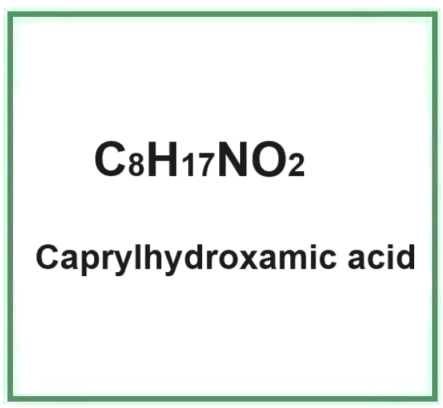Caprylhydroxamic acid is a chemical compound, the dipotassium salt of glycyrrhizin, the most important component of liquorice root extract.
The name describes the structure of the molecule:
- Capryl refers to caprylic acid, a medium-chain fatty acid. This part of the molecule contributes to its lipophilic (fat-soluble) properties.
- hydroxamic refers to a specific functional group known as hydroxamic acid, characterized by a hydroxyl group (-OH) attached to an amide (NH2) group. Hydroxamic acids are known for their chelating properties, i.e., the ability to bind metal ions.
Raw Materials and Their Functions
Caprylic Acid. A medium-chain fatty acid derived from natural sources like coconut oil. It provides the basic structure of caprylhydroxamic acid.
Hydroxylamine. A molecule that provides the hydroxylamine functional group, necessary for the formation of caprylhydroxamic acid.
Industrial Chemical Synthesis of Caprylhydroxamic Acid
- Preparation. The mixture is prepared by combining caprylic acid and hydroxylamine. These two compounds react together in a condensation reaction where a bond is formed between caprylic acid and hydroxylamine.
- Reaction Control. The reaction is monitored to ensure it proceeds correctly and the desired product is formed in the right proportions.
- Purification. After the reaction, the product is purified to remove impurities and by-products, using techniques like crystallization or filtration.
- Quality Control. The final product undergoes quality checks
Form and Color
Caprylhydroxamic acid appears as a white crystalline powder.

What it is used for and where
Cosmetics
Chelating agent. It has the function of preventing unstable reactions and improving the bioavailability of chemical components within a product, and removes calcium and magnesium cations that can cause cloudiness in clear liquids.
Preservative. Any product containing organic, inorganic compounds, water, needs to be preserved from microbial contamination. Preservatives act against the development of harmful microorganisms and against oxidation of the product.
Safety
Caprylhydroxamic acid is believed to be a safe product with antioxidant properties, however, some contact dermatitis has been found recently, so the scientific literature considers this component to be an allergen (1).
Molecular Formula C8H17NO2
CAS 7377-03-9
EC number 230-936-7
References________________________________________________________________________
(1) Ackermann L, Virtanen H, Korhonen L, Laukkanen A, Huilaja L, Riekki R, Hasan T. An epidemic of allergic contact dermatitis caused by a new allergen, caprylhydroxamic acid, in moisturizers. Contact Dermatitis. 2017 Sep;77(3):159-162. doi: 10.1111/cod.12787. Epub 2017 Apr 19. PMID: 28421670.
![]() Caprylhydroxamic acid
Caprylhydroxamic acid 


